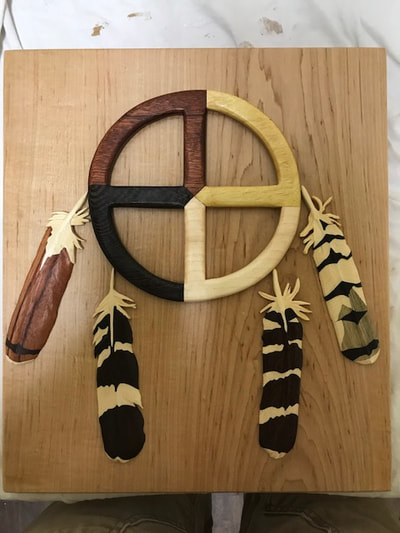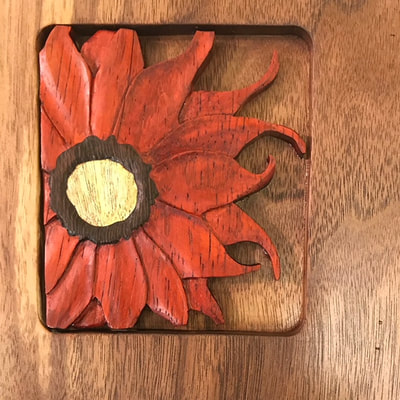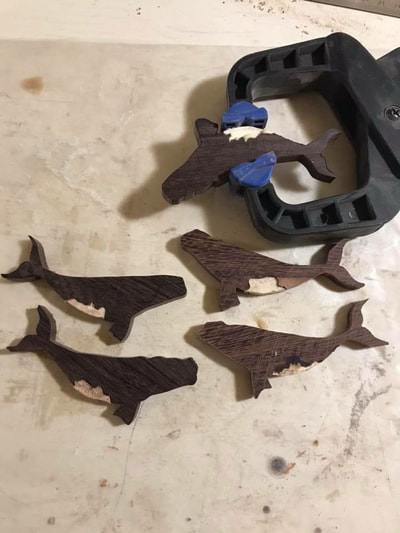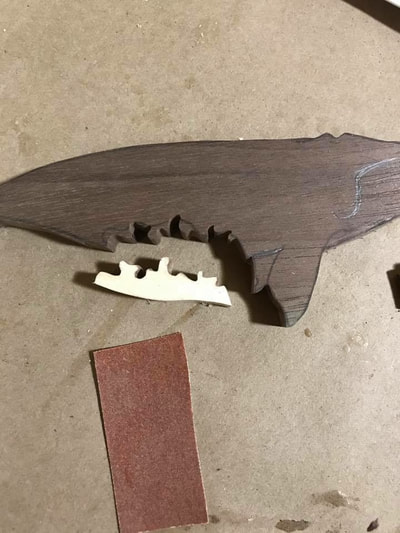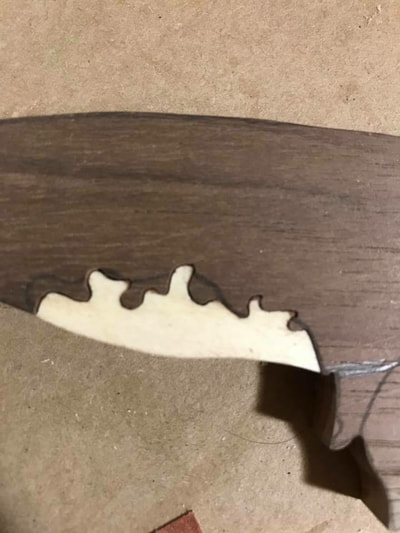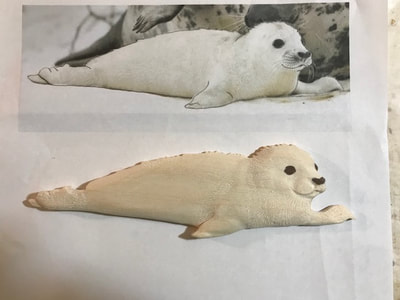About the shop:
People have asked how I make these items and if I paint my carvings. I never use paint or stain on any of my products, all of the detail you see is acquired by puzzling together different species of wood.
Wood comes in lots of colors- red (bloodwood), yellow (yellowheart), orange (ebiara, Paduk, some cherry), almost black (wenge) purple (purpleheart) grey (blue pine) and of course a million shades of brown. Some wood has figuring that resembles a sunset (canary wood) or a beach (spalted maple). I use different species of wood to make things look as close as I can to whatever photo I am working from. I do a lot of the cutting of shapes on a scroll saw, sometimes using a jeweler's coping saw for really tight curves. Then I put the pieces together like a puzzle, glue them together once I am happy with how they fit, and shape them. I use hand tools to carve, but will also use a belt sander (dangerous) or slip a router bit into a Dremel tool and use it to carve.
I fell in love with woodworking years ago helping a friend who turned wooden bowls and made custom wooden cabinetry. I developed my own woodworking style and use my craft to help several important non profit organizations mainly on Cape Cod, Massachusetts and now also in Canada and other critical right whale habitat areas. There is a list below of some of the non profits and a brief description of their work. I use sustainably harvested domestic hardwoods in my work, and only use responsibly harvested tropical woods when needed for accents and color. I always pick highly figured, interesting lumber to ensure products that are both original and beautiful, and use solid slabs of lumber when possible for one of a kind cutting boards.
I finish my pieces with oils and finishes that are food safe and environmentally friendly, and ship products using as little plastic as possible. I think it all makes a difference. Hope you have a look around the shop and email me if you have questions at [email protected].
Enjoy!
-Sheri
People have asked how I make these items and if I paint my carvings. I never use paint or stain on any of my products, all of the detail you see is acquired by puzzling together different species of wood.
Wood comes in lots of colors- red (bloodwood), yellow (yellowheart), orange (ebiara, Paduk, some cherry), almost black (wenge) purple (purpleheart) grey (blue pine) and of course a million shades of brown. Some wood has figuring that resembles a sunset (canary wood) or a beach (spalted maple). I use different species of wood to make things look as close as I can to whatever photo I am working from. I do a lot of the cutting of shapes on a scroll saw, sometimes using a jeweler's coping saw for really tight curves. Then I put the pieces together like a puzzle, glue them together once I am happy with how they fit, and shape them. I use hand tools to carve, but will also use a belt sander (dangerous) or slip a router bit into a Dremel tool and use it to carve.
I fell in love with woodworking years ago helping a friend who turned wooden bowls and made custom wooden cabinetry. I developed my own woodworking style and use my craft to help several important non profit organizations mainly on Cape Cod, Massachusetts and now also in Canada and other critical right whale habitat areas. There is a list below of some of the non profits and a brief description of their work. I use sustainably harvested domestic hardwoods in my work, and only use responsibly harvested tropical woods when needed for accents and color. I always pick highly figured, interesting lumber to ensure products that are both original and beautiful, and use solid slabs of lumber when possible for one of a kind cutting boards.
I finish my pieces with oils and finishes that are food safe and environmentally friendly, and ship products using as little plastic as possible. I think it all makes a difference. Hope you have a look around the shop and email me if you have questions at [email protected].
Enjoy!
-Sheri
The non profits:
CCS: Established in 1976, Center for Coastal Studies in Provincetown, Ma has been a leader in the preservation of marine mammals and ecosystems. Their scientists, naturalists and researchers have rescued over 200 whales and sea turtles from life threatening entanglements, helped develop policies to reduce impacts of people on marine species such as the critically endangered Right Whale, and developed educational programs for students in marine sciences and visitors to the Cape. They also provide valuable internships for college students seeking careers in marine science and research, host public lectures on important marine ecology topics and have a number of fun events to raise awareness of marine species, habitat and coastal ecology.
NMLC: National Marine Life Center is an amazing little operation in Bourne, MA. They rehabilitate and release stranded marine mammals and sea turtles, and also play a huge role in educating both students and visitors to the center about these animals by offering internships, volunteer opportunities and learning environments for school kids and visitors to the Cape.
AWSC: Atlantic White Shark Conservancy is a non profit dedicated to raising awareness of white sharks through research and education. They support research through tagging and monitor and research movement of this species in coastal waters off the Cape and Islands. AWSC believes public education about white sharks will raise awareness and appreciation for the species and secure the future for these amazing creatures.
NECWA: New England Coastal Wildlife Alliance is an all volunteer non profit organization that works to better understand and protect marine wildlife in the coastal waters of New England. Their work intertwines research and education with conservation activities and provides Marine Wildlife internships for high school and college students. Each year NECWA provides between 60 and 70 educational programs to kids and also shares important data they have collected with state and federal managers. They are currently working with Bridgewater State University to archive all of their data to make the information available to the public through an online system. (Abbreviated description from Krill Carson)
A Place Called Hope Located not on the Cape, but instead in Killingworth, CT A Place Called Hope rescues and rehabilitates birds of prey such as eagles, hawks, harriers, falcons, kites and osprey. They also have helped ravens, blue jays, crows and vultures.They make every attempt to release these birds back into the habitat where they were found, often to a waiting mate, and also re-nest fallen fledglings in nest boxes or platforms so parent birds can resume care.
CCS: Established in 1976, Center for Coastal Studies in Provincetown, Ma has been a leader in the preservation of marine mammals and ecosystems. Their scientists, naturalists and researchers have rescued over 200 whales and sea turtles from life threatening entanglements, helped develop policies to reduce impacts of people on marine species such as the critically endangered Right Whale, and developed educational programs for students in marine sciences and visitors to the Cape. They also provide valuable internships for college students seeking careers in marine science and research, host public lectures on important marine ecology topics and have a number of fun events to raise awareness of marine species, habitat and coastal ecology.
NMLC: National Marine Life Center is an amazing little operation in Bourne, MA. They rehabilitate and release stranded marine mammals and sea turtles, and also play a huge role in educating both students and visitors to the center about these animals by offering internships, volunteer opportunities and learning environments for school kids and visitors to the Cape.
AWSC: Atlantic White Shark Conservancy is a non profit dedicated to raising awareness of white sharks through research and education. They support research through tagging and monitor and research movement of this species in coastal waters off the Cape and Islands. AWSC believes public education about white sharks will raise awareness and appreciation for the species and secure the future for these amazing creatures.
NECWA: New England Coastal Wildlife Alliance is an all volunteer non profit organization that works to better understand and protect marine wildlife in the coastal waters of New England. Their work intertwines research and education with conservation activities and provides Marine Wildlife internships for high school and college students. Each year NECWA provides between 60 and 70 educational programs to kids and also shares important data they have collected with state and federal managers. They are currently working with Bridgewater State University to archive all of their data to make the information available to the public through an online system. (Abbreviated description from Krill Carson)
A Place Called Hope Located not on the Cape, but instead in Killingworth, CT A Place Called Hope rescues and rehabilitates birds of prey such as eagles, hawks, harriers, falcons, kites and osprey. They also have helped ravens, blue jays, crows and vultures.They make every attempt to release these birds back into the habitat where they were found, often to a waiting mate, and also re-nest fallen fledglings in nest boxes or platforms so parent birds can resume care.
